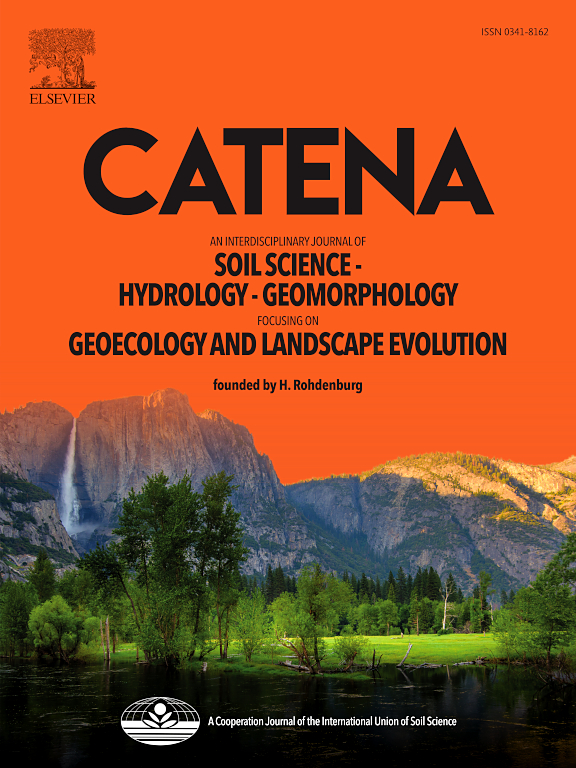Fire differentially affects soil properties of forests and grasslands: A global meta-analysis
IF 5.7
1区 农林科学
Q1 GEOSCIENCES, MULTIDISCIPLINARY
引用次数: 0
Abstract
Fire is one of the most frequent disturbances in ecosystems, exerting profound effects on soil structure and nutrient dynamics. However, its impact on soil physical, chemical, and biological properties and the differences in soil responses to fire between forests and grasslands at a global scale have not been systematically evaluated. To address this gap, we constructed a global database of fire-induced soil changes, which includes data from 253 studies (1,896 observations of grassland soil properties and 3,425 observations of forest soil properties). We found that, globally, fire increased soil bulk density (BD), pH, and available phosphorus (AP) by 1.1–17.9 %, while it decreased soil water content (SWC), mean weight diameter (MWD), soil respiration (SR), soil total carbon (TC), total nitrogen (TN), soil organic matter (SOM), and the C/N ratio by 3.7–22.9 %. In forests, soil properties were more strongly affected by fire compared to grasslands, with effect sizes 1.02–32.0 times greater, except for soil potassium and magnesium, which exhibited contrary changes. Variation partitioning indicated that fire-induced soil changes in forests were explained by geoclimatic conditions (72.1 %) and fire characteristics (24.3 %), whereas in grasslands, the soil changes were predominantly explained by fire characteristics (79.1 %) rather than geoclimatic conditions (15.4 %). Path analysis revealed that post-fire time, mean annual precipitation (MAP), and mean annual temperature (MAT) increased the soil effect sizes in forests, with coefficients of 0.06, 0.09 and 0.08 (p < 0.05), respectively. Conversely, in grasslands, post-fire time and fire intensity directly decreased soil effect sizes, with coefficients of −0.13 and −0.06 (p < 0.05), respectively. These findings highlight the differences in the response of soil properties to fire between forests and grasslands, determined by climate factors and fire characteristics. Our resulets advance the mechanistic comprehension of differential responses in soil properties to fire in global forest and grassland ecosystems, particularly in the context of climate change and the escalating frequency of fire disturbances.
火灾对森林和草原土壤性质的不同影响:一项全球荟萃分析
火灾是生态系统中最常见的干扰之一,对土壤结构和养分动态产生深远影响。然而,在全球尺度上,其对土壤物理、化学和生物特性的影响以及森林和草地土壤对火灾反应的差异尚未得到系统评价。为了弥补这一空白,我们构建了一个全球火灾引起的土壤变化数据库,其中包括253项研究的数据(1,896项草地土壤性质观测和3,425项森林土壤性质观测)。结果表明,在全球范围内,火灾使土壤容重(BD)、pH和速效磷(AP)增加了1.1 ~ 17.9%,土壤含水量(SWC)、平均重径(MWD)、土壤呼吸(SR)、土壤全碳(TC)、全氮(TN)、土壤有机质(SOM)和C/N比降低了3.7 ~ 22.9%。在森林中,土壤性质受火的影响比草地更强烈,效应量是草地的1.02 ~ 32.0倍,但土壤钾和镁的变化相反。变异分区结果表明,森林土壤变化主要受气候条件(72.1%)和火灾特征(24.3%)的影响,而草地土壤变化主要受火灾特征(79.1%)的影响,而非气候条件(15.4%)的影响。通径分析显示,火灾后时间、年平均降水量(MAP)和年平均气温(MAT)增加了森林土壤效应大小,其系数分别为0.06、0.09和0.08 (p <;分别为0.05)。相反,在草地上,火灾后时间和火灾强度直接降低了土壤效应大小,系数分别为- 0.13和- 0.06 (p <;分别为0.05)。这些发现强调了森林和草原土壤性质对火灾的反应的差异,这是由气候因素和火灾特征决定的。我们的研究结果促进了对全球森林和草地生态系统中土壤特性对火灾的不同响应的机制理解,特别是在气候变化和火灾干扰频率不断上升的背景下。
本文章由计算机程序翻译,如有差异,请以英文原文为准。
求助全文
约1分钟内获得全文
求助全文
来源期刊

Catena
环境科学-地球科学综合
CiteScore
10.50
自引率
9.70%
发文量
816
审稿时长
54 days
期刊介绍:
Catena publishes papers describing original field and laboratory investigations and reviews on geoecology and landscape evolution with emphasis on interdisciplinary aspects of soil science, hydrology and geomorphology. It aims to disseminate new knowledge and foster better understanding of the physical environment, of evolutionary sequences that have resulted in past and current landscapes, and of the natural processes that are likely to determine the fate of our terrestrial environment.
Papers within any one of the above topics are welcome provided they are of sufficiently wide interest and relevance.
 求助内容:
求助内容: 应助结果提醒方式:
应助结果提醒方式:


